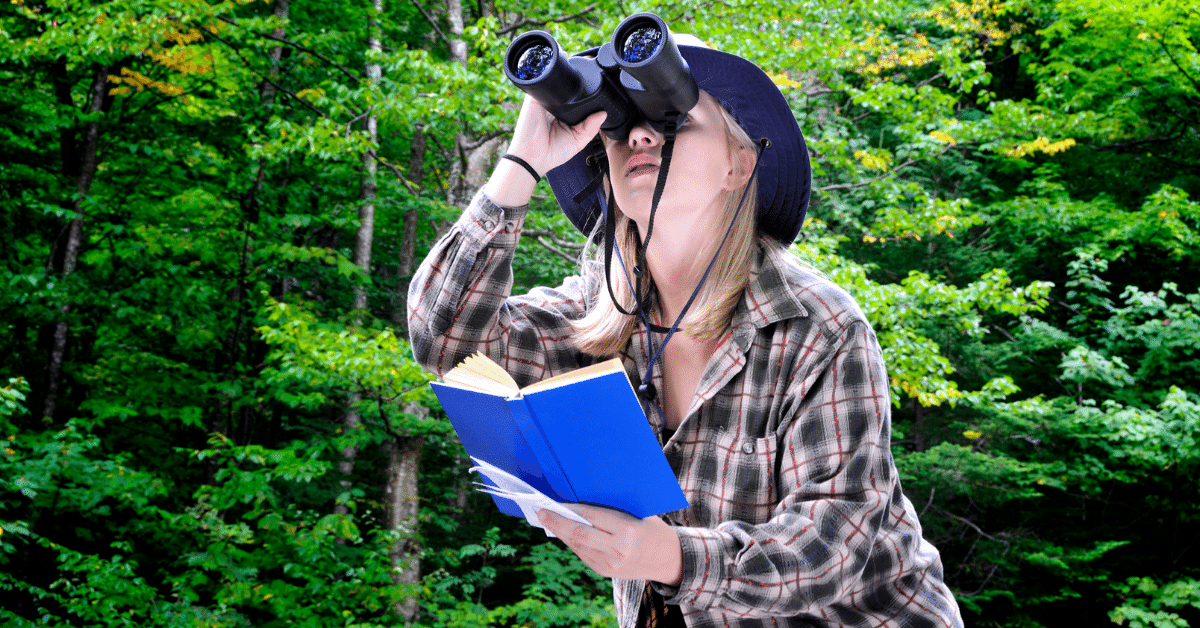‘Are you ready to take your birding game to the next level? With the right pair of binoculars, you can do just that! Read on to find out our top picks for the best binoculars for birding. Get ready to transform your outdoor experience into an avian adventure!
Bird watching is becoming increasingly popular and binoculars are an essential part of the process. For birders to successfully watch birds, they must have a pair of good quality binoculars to get close and see birds in detail.
Binoculars come in a variety of shapes and sizes, each suited for different types of birding activities. When selecting binoculars, it’s important to consider your budget and the type of birds you plan to observe. Magnification, lens coatings, size, weight and field of view are other important factors that should be considered when selecting birding binoculars.
Top 5 Binoculars for Birding in 2025
Choosing the right binoculars for bird watching can be difficult especially for those who have not done much research on them as there is so much information available including specs and brand names. However, by understanding what features are important for your particular needs, you can make an informed decision on the best option for you.
- 【HIGH-POWERED LARGE EYEPIECE BINOCULARS】 This binoculars for adults has 12x magnification, 25mm objective lens and wide field of view, 273ft/1000yds, letting you look farther and see wider. Coating with FMC Broadband coating and premium BAK4 prism, it ensure imaging verisimilar.
- 2023 UPGRADED BINOCULARS – Our premium binoculars feature a high magnification 20x zoom eyepiece and a 168 yard field of view at 1000 yards, allowing you to see and focus on the huge detail of your target from 1000 yards away. The super long distance between super broad and clear vision. It’s ideal binoculars for adults bird watching, hunting, camping, climbing, hiking, safari, travel, opera, concert, sports events, and stargazing.
- 10 magnification with 25mm objective lens provides high definition without a color-changed or blurred image. The 10 magnification boasts a viewing field of 362ft at 1000 yds, so you’ll be able to observe a great deal without actually adjusting their position.
- 🐧【𝟏𝟓𝐱 𝐇𝐢𝐠𝐡-𝐏𝐨𝐰𝐞𝐫𝐞𝐝 𝐁𝐢𝐧𝐨𝐜𝐮𝐥𝐚𝐫𝐬: 𝐃𝐢𝐬𝐜𝐨𝐯𝐞𝐫 𝐍𝐚𝐭𝐮𝐫𝐞’𝐬 𝐒𝐦𝐚𝐥𝐥𝐞𝐬𝐭 𝐃𝐞𝐭𝐚𝐢𝐥𝐬】Elevate your viewing experience with these 15x high-powered binoculars designed for adults. Crafted for observing extremely long distances, these professional high-powered binoculars provide a razor-sharp view of the smallest details even at longer ranges. Unlock the smallest secrets of nature and immerse yourself in crisp, razor-sharp visuals that traditional 12x magnification binoculars cannot match.
Binoculars for Birding
Binoculars for birding should be designed specifically for your needs and preferences. When considering which binoculars to buy, there are several key components to consider.
First, consider size and weight; a pair of binoculars that is too large or heavy may be too cumbersome to bring on bird-watching excursions. You will want lightweight models with appropriate magnification if you plan to use the binoculars while walking or standing; however, if you will be mostly sitting while viewing, you may also appreciate larger optics that can increase the viewing experience.
Magnification and objective lens size are also important specifications of binoculars meant for birding. Magnification of 7x to 10x is most commonly chosen by experienced birders; this increases the size of an image without making it look blurred. The larger the objective lens is, the more light can enter the ocular lenses, providing a brighter image and improved resolution in low-light conditions. For general use during hours of daylight, 42mm to 44mm is recommended for mid-sized optics and 50mm when using large models.
Finally, a good coating on lenses can make all the difference in viewing comfort. Look for multi-coatings which lend greater glare protection and more depth of field clarity than single coatings offer. Coatings such as dielectric prism coatings transmit colors evenly so images appear crisp with true colors naturally represented rather than distorted by reflection off surfaces like lesser coatings do. Other features such as waterproof housing may also be important depending upon where you use your optics. No matter which model you choose, investing in quality optics will greatly improve your bird watching experience!
Types of Binoculars
Whether you’re a serious bird watcher or just looking to expand your hobby, the right pair of binoculars can make all the difference in observing birds in their natural habitat. A good set of binoculars should be lightweight with high image contrast, optical clarity and large objective lenses for increased light gathering capabilities. Binoculars come in different magnifications and sizes that cater to various uses, so before purchasing it’s important to understand your needs and what type of binocular is best for birding.
Roof Prism Binoculars: This type of binocular is preferred by many experienced bird watchers. Roof prism binoculars look sleek and come equipped with high-quality lenses wrapped in coated rubber armor for a secure grip. Optically they possess less chromatic aberration and field curvature than do Porro prism designs, resulting in brighter images and minimum deflection at the outer edges of the field view.
Porro Prism Binoculars: These styles feature angled barrels relative to the objectives (eye pieces). Porro prism models offer better depth perception than do roof prism designs but tend to be slightly larger and less compact due to their design. They also have a tendency to have greater chromatic aberration (color fringing) along their edges as compared with roof prisms models because light rays traveling through these types of devices zigzag around more corners than those utilizing roof prisms reflectors or glass plates woven into the body tubes which cause total internal reflection before exiting the eyepiece lenses, minimizing aberrations caused by variations in wavelength across the color spectrum from red-to-blue.
Compact Binoculars: Compact models are lightweight versions that offer portability without sacrificing optical performance. They are great for those who want to take their equipment on hikes or those who need an unobtrusive pair when birdwatching in natural settings as they may not scare off some species with larger shapes and sizes like most traditional models would do if spotted by birds nearby while being used often unfamiliar sight given their generally muted colors instead compared with others’ brighter hues.
Binocular Magnification
When shopping for binoculars, an important factor to consider is magnification. Binoculars are usually labeled with two numbers and represent the binoculars magnification power. The first one is the magnification power, or how many times the object you are looking at is magnified by the lenses. Commonly, this number is 8x, 10x or 12x — the higher this number is, the larger an object appears in your viewfinder. The second figure usually ranges from 20 to 50 and indicates the diameter of each of front lens measured in millimeters (e.g., 10 x 42). A higher figure for second one means brighter image with a wider field view. Before making your purchase, read reviews on various products to understand which option best suits your needs and desired level of performance.
Binocular Objective Lens
The objective lenses are the part of binoculars that contain the glass elements responsible for magnifying your view. Most binoculars have objective lenses that range from 25mm to 50mm in size, and larger lenses provide higher brightness levels and greater light transmission. The larger the objective lens, the more butterflies and other delicate creatures you can observe from a distance.
Wide-angle binoculars are great for birders because they offer a wider field of view than standard binoculars. Narrow-angle models provide a more powerful zoom at the cost of field-of-view, with any lens between 8x and 10x offering superior light capture and image quality at longer distances. For medium to long range viewing, higher powered binoculars will be best as they can reveal more detail and assist with identification.
It is important to consider the physical size of any pair of binoculars; while bigger lenses can provide better views, they are also heavier in weight unless constructed out of lighter materials such as carbon fiber or magnesium alloy. Smaller sized optics might be too heavy for some users when mounted on tripod stands or carried in backpacks when going on extended hikes into areas inhabited by birds you want to observe up close. This consideration may drive you to opt for mid-size or compact optics rather than full size bins depending on your pursuits!
Binocular Exit Pupil
The key feature for selecting a good pair of birding binoculars is the Exit Pupil, which is a measure of the amount of light from an image that reaches your eye. Generally, the higher the number, the brighter and more detailed view you will have. The Exit Pupil size is determined by dividing the objective lens diameter by magnification. For instance, a 8x42mm binocular has an exit pupil size of 5.25mm (42/8 = 5.25).
To determine how well binoculars will perform in dim or low light conditions, it’s important to know that exit pupils greater than 7mm are ideal for bird watching during twilight and dawn hours when birds are most active but light conditions can be challenging. If you’re looking for a pair to use primarily during daylight hours and don’t require extra brightness then an exit pupil size between 3.5 — 4mm may be sufficient but won’t give as nice an image in low light conditions as larger models would.
Binocular Field of View
When using binoculars for birding, there are several features to consider before purchasing a pair of binoculars. The biggest factor is the field of view. Binoculars with a wide field of view make it easier to track birds in flight and in dense foliage. This is measured by two numbers, expressed in degrees or feet at 1000 yards. The higher the first number, the wider the field of view of your binoculars. Typical binoculars can range from 200 to 420 feet at 1000 yards (or 7°-60°).
Another important factor is size and weight — bigger isn’t always better when it comes to spending extended periods outdoors birding. Too heavy a pair may leave your arms tired after hours of searching for birds through your binoculars. Additionally, size and weight make it easier or harder to carry your pair comfortably on your next birding excursion.
The other significant factor worth considering is magnification or “power”. Generally speaking with bins, the higher the power number (the second number), the more magnified your image will be but also the more prone you are to hand jitter which can make it difficult to accurately identify flying birds or ones very far away . A zoom feature that allows you control both magnification and field of view can help here because you don’t have to compromise one for the other — having larger fields at different magnifications gives you greater flexibility for chasing after birds wherever they go! Mid-range powers such as 8×42 and 10×50 have proven very popular among experts due their balance between size and function.
Conclusion
At the conclusion of this exploration into the features and benefits of binoculars designed specifically for birding, it is clear that there are a multitude of choices available. Ultimately, all birders should seek out a pair that meets their needs in terms of both budget and quality. Whether selecting from compact, full-size, or waterproof options, knowing these differences can help identify which is best for your unique birding needs.
In addition to these technical considerations, look at price points and specific warranties offered by different brands. High-end optics help with magnification power and resolution but can be more expensive and heavier than mid-range binoculars. That said, less advanced models may need more frequent adjustment to maintain desired focus and image clarity during use. Some manufacturers stand behind their products with lifetime warranties or repair services, so it is also important to factor in after-sale support into one’s choice of binoculars for birding.







